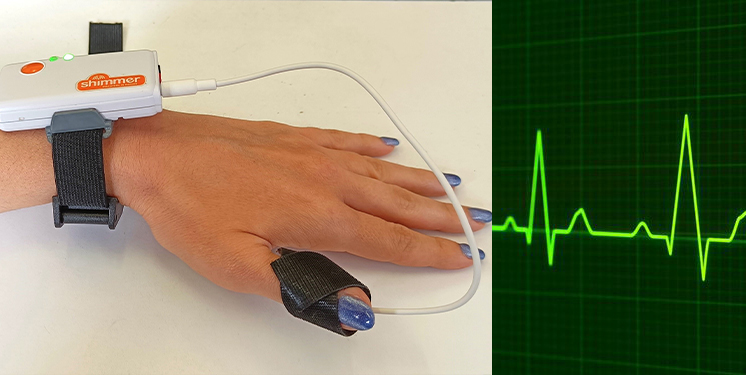Photoplethysmography (PPG) is performed with a non-invasive technology, an infrared optical sensor, that employs a light source and a photodetector at the surface of skin. It consists of an optical measurement method to detect the volumetric changes in blood circulation.
The PPG signal is very easy to record by placing the sensor on the finger, on the wrist or on the earlobe. The recent development of new commercial healthcare devices, including wearable items such as wristbands and smartwatches, has made such measures increasingly accessible for use in research activities within the neuroscience domain, even in non-laboratory settings.
Between the several parameters and measures that can be derived from the PPG signal, an interesting measure is that related to the frequency of cardiac contractions, named Heart Rate (HR) and measured in beats per minute (bpm).
The Heart rate can vary according to the body's physical needs, including the need to absorb oxygen and excrete carbon dioxide. It is usually equal to the pulse measured at any human body peripheral point. Some activities such as physical exercise, sleep, anxiety, stress, illness and ingestion of drugs, can provoke changes at the HR level.
The normal resting adult human Heart Rate ranges from 60–100 bpm. Tachycardia is a fast Heart Rate, defined as above 100 bpm at rest. Bradycardia is a slow Heart Rate, defined as below 60 bpm at rest. During sleep a slow heartbeat with rates around 40–50 bpm is common and is considered normal. When the heart is not beating in a regular pattern, this is referred to as an arrhythmia. These abnormalities of heart rate sometimes indicate disease.
Besides the clinical applications, psychophysiological studies highlighted the relationship between the Heart Rate variations and the human emotional reactions. In fact, Heart Rate is regulated by the Autonomic Nervous System (ANS). In particular, positive emotions such joy or appreciation elicit the reaction of the Sympathetic branch (SNS) of the autonomic nervous system, reflected by an Heart Rate increasing with respect to the subjective baseline. On the contrary, negative emotions such fear or disappointment elicit the reaction of the Parasympathetic branch (PNS), with a consequently decreasing of the Heart Rate. Additional studies highlighted the relationship between HR signal and some mental states, such as stress, focal attention, drowsiness and engagement.
In BrainSigns this signal is included as a dimension in emotional index or combined with others signals to measure stress conditions.









